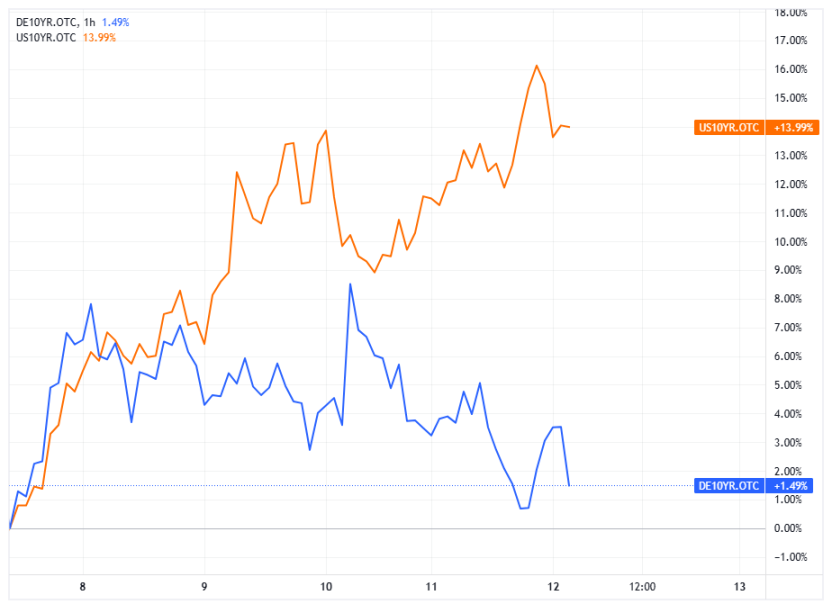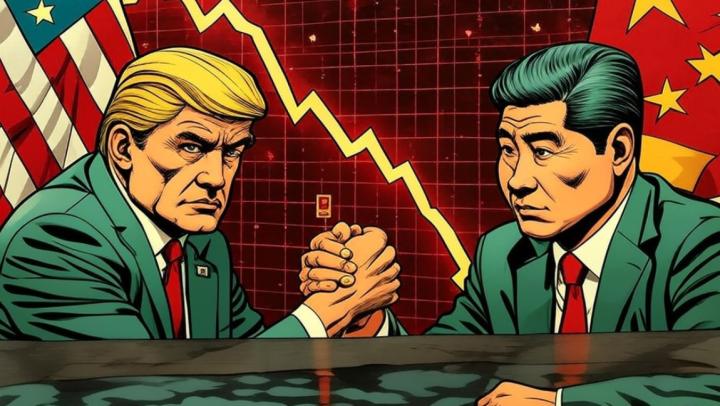US stock volatility has rarely exceeded emerging markets and Bitcoin, while US Treasuries, traditionally considered safe assets, are experiencing severe fluctuations, causing investors to question the wisdom of holding US assets. UBS believes that once global risk-free rates fluctuate, it will disrupt all markets. Analyst Ed Al-Hussainy pointedly stated: "I'm not worried about a recession, I'm worried about a financial crisis."
US stocks rebounded on Friday, seemingly restoring market risk appetite, but investors have already begun to question the safety of US assets, especially the dramatic volatility of US Treasuries, which has once again shrouded Wall Street with fears of a financial crisis.
In the past week, the US 10-year Treasury yield saw the largest single-week jump in over 20 years, with US stocks diving and then surging. On the surface, the S&P 500 index rose over 5% for the week, Treasury yields returned to February levels, and Bitcoin closed higher, appearing normal.
However, what is unsettling is that this week's simultaneous decline in US stocks, Treasuries, and the US dollar is typical of emerging markets, not the performance of the world's safest assets. Especially with the significant volatility in long-term US bonds this week, a liquidity crisis seems imminent, causing investors to question the wisdom of holding US assets. UBS Group's Chief Strategist Banu Baveja stated:
This is terrifying. We are redefining global risk-free rates, and if global risk-free rates fluctuate, it will disrupt all markets.
Historically Rare: US Asset Volatility Surpasses Emerging Markets and Bitcoin
Trump's recent tariff policies have not only damaged confidence in the US economy but also shaken investors' trust in US policy direction and dollar assets. Even by Wall Street's long historical standards, this was a brutal trading week, with US stocks riding a roller coaster and the movements of US Treasuries and the dollar suggesting that the US's safe-haven status might be at risk:
- Monday: Due to a supposed "tariff information error," US stocks experienced a 15-minute pulse-like massive shock, with Nasdaq briefly plummeting 10%, and Treasuries diving.
- Tuesday: News of no tariff exemptions crushed hopes of a stock rebound, with the Dow dropping over 2,000 points intraday and the S&P erasing over 4% gains, while the US Treasury market experienced a deleveraging-style massive decline.
- Wednesday: The US temporarily suspended some tariffs, with the three major US stock indices rising at least 8%, the S&P recording its largest gain since 2008, and trading volume hitting a historical high of 3 billion shares. The 10-year Treasury yield surged and then retreated.
- Thursday: Global investors fled US assets, with a triple hit to US stocks, bonds, and currency. Nasdaq fell over 4%, the dollar saw its largest one-day drop in two years, and gold reached new highs.
- Friday: With the Fed hinting at potential intervention, US stocks rebounded and closed higher, but the continued decline of Treasuries and the dollar warned that the US's safe-haven status might be in jeopardy.
Confidence in the quality of U.S. stocks, fixed income, and currency assets outside the United States has been damaged. Fund manager Nathan Thooft stated, "The question is whether this is a temporary shock or a long-term change? We still believe it is the former. However, this does not deny that some large asset owners are looking for alternatives and diversification of hedging assets."
Analyst Ed Al-Hussainy pointedly noted: I'm not worried about a recession, I'm worried about a financial crisis.
Funds Flow to Hedging Assets, Wall Street Calls for Federal Reserve Intervention
The shadow of a financial crisis has led global investors to withdraw from the U.S. and rush into European bond markets, gold, the Japanese yen, and Swiss franc as hedging assets to avoid broader turbulence.
German bond yields remained essentially unchanged this week, while U.S. 10-year bond yields surged by over 50 basis points, the largest gap between U.S. and German Treasury yields since 1989. In contrast, the U.S. dollar index fell below the 100 psychological level, recording its worst two-week decline since November 2022, while the euro significantly appreciated against the dollar, rising more than the Japanese yen this week.

Extreme volatility has brought unprecedented psychological pressure to investors and traders, with Wall Street already calling for Federal Reserve intervention. On Friday, JPMorgan CEO Dimon stated that he expects the U.S. Treasury market to become "chaotic".
"When you have many volatile markets, very wide Treasury trading spreads, and low liquidity, it affects all other capital markets," Dimon said during the earnings call, "This is a reason the Federal Reserve should intervene, not to help banks."
Fortunately, Federal Reserve board member Susan Collins stated on Friday that if market conditions become chaotic, the Federal Reserve would be "absolutely prepared" to help stabilize financial markets. However, she also emphasized that the markets continue to function well, and they do not see overall liquidity concerns.







